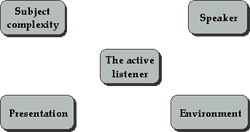Kiosk
A man's silence is wonderful to listen to.
Thomas Hardy
1840 - 1928 English novelist/poet |
Cooperative learning series
Active listening
What affects listening?
Active listening intentionally focuses on who you are listening
to,
whether in a group or one-on-one, in order to understand
what he or she is saying.
As the listener, you should then be able to repeat back in your
own words what they have said to their satisfaction. This does not
mean you agree with the person,
but rather understand what they are
saying.
|
What do you think of the |
Is the speaker experienced or
nervous? |
|
|
|
|
Is the message illustrated with |
Is the space conducive to listening? |
Described above are the external factors.
Now: what about you, the center, the listener?
Prepare with a positive, engaged attitude
- Focus your attention on the subject
Stop all non-relevant activities beforehand to orient yourself
to the speaker or the topic - Review mentally what you already know about the subject
Organize in advance relevant material in order to develop it further
(previous lectures, TV programs, newspaper articles, web sites, prior real life experience, etc.) - Avoid distractions
Seat yourself appropriately close to the speaker
Avoid distractions (a window, a talkative neighbor, noise, etc.) - Acknowledge any emotional state
Suspend emotions until later, or
Passively participate unless you can control your emotions - Set aside your prejudices, your opinions
You are present to learn what the speaker has to say,
not the other way around
Actively listen
- Be other-directed; focus on the person communicating
Follow and understand the speaker as if you were walking in their shoes
Listen with your ears but also with your eyes and other senses - Be aware: non-verbally acknowledge points in the speech
Let the argument or presentation run its course
Don't agree or disagree, but encourage the train of thought - Be involved:
Actively respond to questions and directions
Use your body position (e.g. lean forward) and attention to encourage the speaker and signal your interest
Follow up activities
One-to-one
Give the speaker time and
space for rest after talking
Express appreciation for the
sharing to build trust and encourage dialogue
Check if you have understood
- Restate key points to affirm your understanding & build dialogue
- Summarize key points to affirm your understanding & build dialogue
- Ask (non-threatening) questions to build understanding
Continue dialogue:
- Reflect on your experience to demonstrate your interest (feedback)
- Interpret after you feel you have grasped content
- Apply what you have learned to a new situation
In a group or audience
give the speaker
space to regroup, to debrief after talking
During Q & A
If posing a question
- Quickly express appreciation
- Briefly summarize a preliminary point
- Ask the relevant question
If making a point
- Quickly express appreciation
- Briefly restate the relevant idea as presented
- State your idea, interpretation, reflection
- Invite a response
Continued development
- Get contact information for later reference
- Invite friends/colleagues/etc. for discussion afterward
- Write out a summary with questions for further review

 Website overview:
Kiosk guides for learning are a freely accessible educational environment that offers strategies to recognize and realize learning objectives. We accept individual differences without regard to ability and creed; sexual and affectional orientation; caste, tribal and national affiliation; individual, familial and collective history. Our suggestions should be thoughtfully considered for appropriateness and guidance to your situation, relying on elders, mentors, cohorts and/or professionals to achieve learning objectives and outcomes.
Website overview:
Kiosk guides for learning are a freely accessible educational environment that offers strategies to recognize and realize learning objectives. We accept individual differences without regard to ability and creed; sexual and affectional orientation; caste, tribal and national affiliation; individual, familial and collective history. Our suggestions should be thoughtfully considered for appropriateness and guidance to your situation, relying on elders, mentors, cohorts and/or professionals to achieve learning objectives and outcomes.